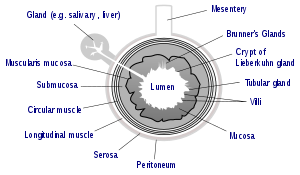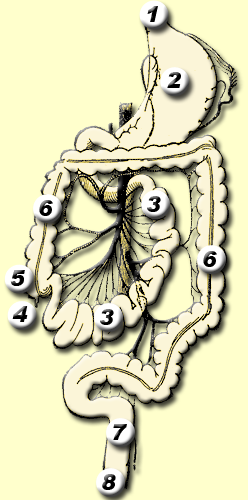The structure and function can be described both as gross anatomy and at a microscopic level. The intestinal tract can be broadly divided into two different parts, the small and large intestine. Grayish-purple in color and about 35 millimeters (1.5 inches) in diameter, the small intestine is the first and longer, measuring 6 to 7 meters (20–23 ft) long average in an adult man. Shorter and relatively stockier, the large intestine is a dark reddish color, measuring roughly 1.5 meters (5 ft) long on average.[2] People will have different sized intestines according to their size and age.
The lumen where digested food passes through and from where Both intestines share a general structure with the whole gut, and are composed of several layers. Going from inside the lumen radially outwards, one passes the mucosa (glandular epithelium and muscularis mucosa), submucosa, muscularis externa (made up of inner circular and outer longitudinal), and lastly serosa.

The general structure of the intestinal wall
- Along the whole length of the gut in the glandular epithelium are goblet cells. These secrete mucus which lubricates the passage of food along and protects it from digestive enzymes. Villi are vaginations of the mucosa and increase the overall surface area of the intestine while also containing a lacteal, which is connected to the lymph system and aids in the removal of lipids and tissue fluid from the blood supply. Microvilli are present on the epithelium of a villus and further increase the surface area over which absorption can take place.
- The next layer is the muscularis mucosa which is a layer of smooth muscle that aids in the action of continued peristalsis and catastalsis along the gut. The submucosa contains nerves (e.g. Meissner's plexus), blood vessels and elastic fibre with collagen that stretches with increased capacity but maintains the shape of the intestine.
- Surrounding this is the muscularis externa which comprises longitudinal and smooth muscle that again helps with continued peristalsis and the movement of digested material out of and along the gut. In between the two layers of muscle lies Auerbach's plexus.
- Lastly there is the serosa which is made up of loose connective tissue and coated in mucus so as to prevent friction damage from the intestine rubbing against other tissue. Holding all this in place are the mesenteries which suspend the intestine in the abdominal cavity and stop it being disturbed when a person is physically active.
The large intestine hosts several kinds of bacteria that deal with molecules the human body is not able to break down itself. This is an example of symbiosis. These bacteria also account for the production of gases inside our intestine (this gas is released as flatulence when eliminated through the anus). However the large intestine is mainly concerned with the absorption of water from digested material (which is regulated by the hypothalamus) and the reabsorption of sodium, as well as any nutrients that may have escaped primary digestion in the ileum.
